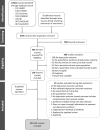Interventions for Depressive Symptoms in People Living with Chronic Pain: A Systematic Review of Meta-Analyses
- PMID: 34373915
- PMCID: PMC9071227
- DOI: 10.1093/pm/pnab248
Interventions for Depressive Symptoms in People Living with Chronic Pain: A Systematic Review of Meta-Analyses
Abstract
Objective: This review investigated the effectiveness of clinical interventions on depressive symptoms in people with all types of chronic pain.
Methods: We searched seven electronic databases and reference lists on September 15, 2020, and included English-language, systematic reviews and meta-analyses of trials that examined the effects of clinical interventions on depressive outcomes in chronic pain. Two independent reviewers screened, extracted, and assessed the risk of bias. PROSPERO registration: CRD42019131871.
Results: Eighty-three reviews were selected and included 182 meta-analyses. Data were summarized visually and narratively using standardized mean differences with 95% confidence intervals as the primary outcome of interest. A large proportion of meta-analyses investigated fibromyalgia or mixed chronic pain, and psychological interventions were most commonly evaluated. Acceptance and commitment therapy for general chronic pain, and fluoxetine and web-based psychotherapy for fibromyalgia showed the most robust effects and can be prioritized for implementation in clinical practice. Exercise for arthritis, pharmacotherapy for neuropathic pain, self-regulatory psychotherapy for axial pain, and music therapy for general chronic pain showed large, significant effects, but estimates were derived from low- or critically low-quality reviews.
Conclusions: No single intervention type demonstrated substantial superiority across multiple pain populations. Other dimensions beyond efficacy, such as accessibility, safety, cost, patient preference, and efficacy for non-depressive outcomes should also be weighed when considering treatment options. Further effectiveness research is required for common pain types such as arthritis and axial pain, and common interventions such as opioids, anti-inflammatories and acupuncture.
Keywords: Chronic Pain; Depression; Effectiveness; Meta-Analysis; Systematic Review; Umbrella Review.
© The Author(s) 2021. Published by Oxford University Press on behalf of the American Academy of Pain Medicine.
Figures



References
-
- Treede RD, Rief W, Barke A, et al. Chronic pain as a symptom or a disease: The IASP Classification of Chronic Pain for the International Classification of Diseases (ICD-11). Pain 2019;160(1):19–27. - PubMed
-
- Bair MJ, Robinson RL, Eckert GJ, Stang PE, Croghan TW, Kroenke K.. Impact of pain on depression treatment response in primary care. Psychosom Med 2004;66(1):17–22. - PubMed
-
- Brody DJ, Pratt LA, Hughes JP.. Prevalence of depression among adults aged 20 and over: United States, 2013-2016. NCHS Data Brief 2018;(303):1–8. - PubMed
Publication types
MeSH terms
Grants and funding
LinkOut - more resources
Full Text Sources
Medical

